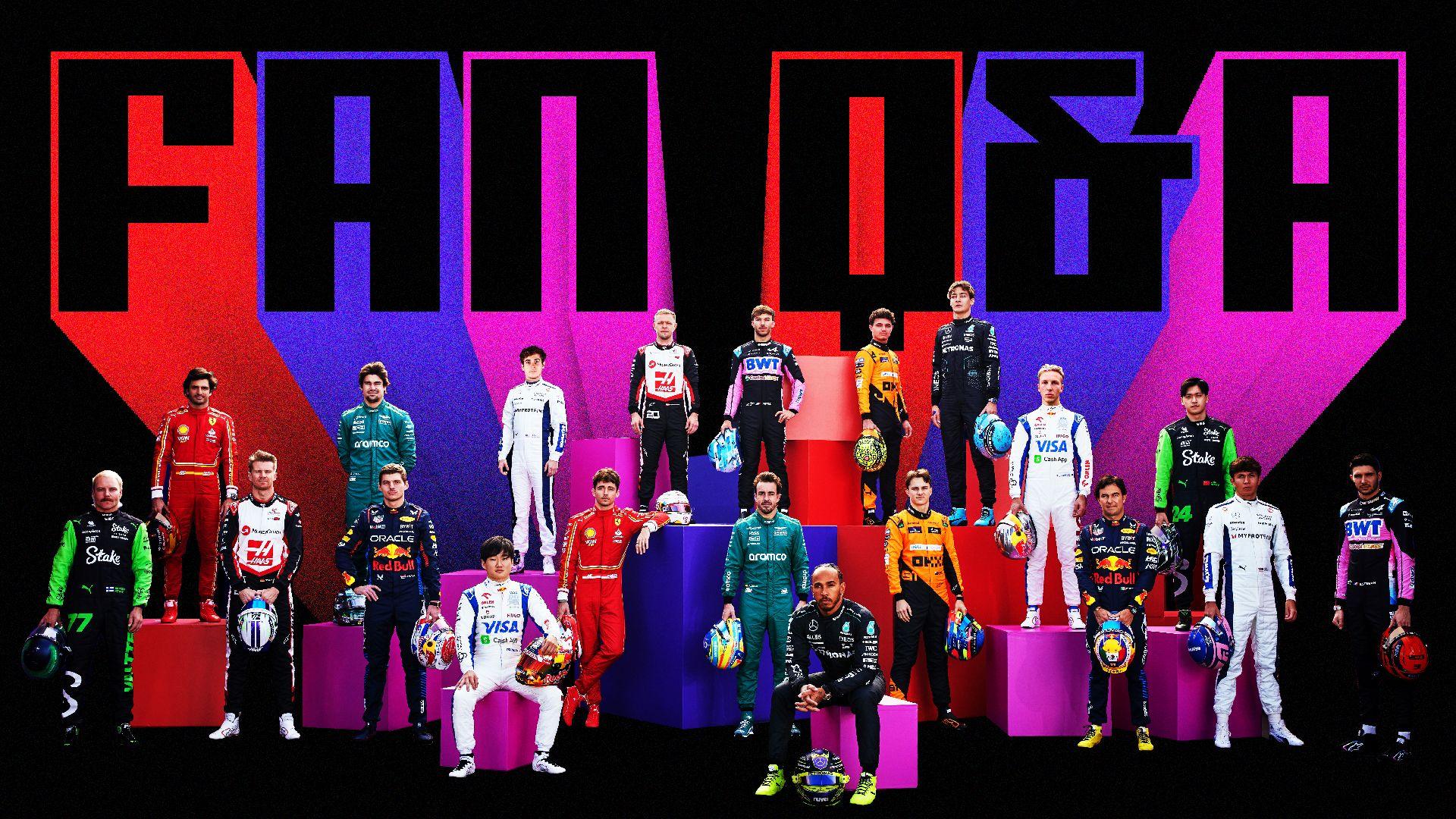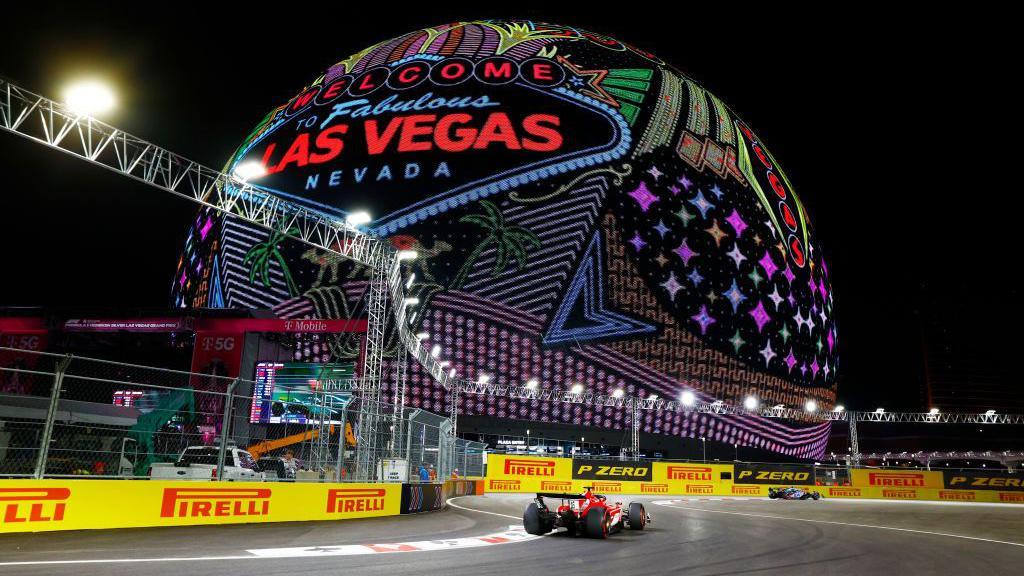Is there hope for Mercedes in 2025? And why does F1 go to Monaco?

- Published
Max Verstappen is on the verge of securing a fourth consecutive drivers' championship as Formula 1 heads to Las Vegas for the first of three races to finish the 2024 season.
The Dutchman leads Lando Norris by 62 points and will win the world title if he leaves Las Vegas with a lead of at least 60.
BBC F1 correspondent Andrew Benson answers your questions on the key talking points in the sport going into Vegas.
Is there any hope for Mercedes in 2025 given their lack of progress over the past three years? – Laura
It’s been another difficult year for Mercedes.
If you look at it one way, it has been their most successful under the regulations that were introduced in 2022 - they have won three races, having won one in 2022 and none last year.
In another, you could say it has been their least successful, because they are poised to finish fourth in the constructors’ championship, after being third in 2022 and second in 2023.
Those three wins came in a run of four races. Two were absolutely on merit - Lewis Hamilton’s victories in Britain and Belgium. In fact, Mercedes crossed the line one-two in Belgium only for George Russell to be disqualified from victory for his car being underweight.
And one was inherited by Russell after Max Verstappen and Lando Norris collided while battling for the lead in Austria.
As a result of that run of form, Mercedes went into the summer break optimistic that they had finally found a way forward with their car, even though there were questions, as a new floor introduced in Belgium was taken off the car after a difficult first day of practice.
After further trials, that floor was eventually abandoned, and the hope was that a development floor introduced for the US Grand Prix would recover all the ground that had been hoped for with the Spa one, and more.
But the jury is still out on that second floor, after the drivers had a series of accidents with it fitted in Austin.
Both cars had it in Brazil and Russell had a strong weekend, qualifying on the front row and leading the race. He might have won had Mercedes not overruled his wish to stay out rather than pit for fresh tyres shortly before the red flag.
But Hamilton had a difficult weekend, never building any confidence in the rear of the car.
There are still three races to go this year. Let’s see how they go for Mercedes before jumping to any conclusions as to whether they have found answers for the problems that emerged through the summer and autumn.
Is the FIA in crisis? Why are so many senior people leaving? Is president Mohammed Ben Sulayem the problem? – Pete
The FIA has indeed lost a series of senior people in the past year.
It started with Deborah Mayer, head of the FIA commission for women, last December. Her exit was followed quickly by those of sporting director Steve Nielsen and single-seater technical director Tim Goss last winter.
Natalie Robyn left her role as chief executive officer in May after just 18 months.
And now race director Niels Wittich and compliance officer Paolo Basarri have gone in the space of a few days. In the case of Wittich, the fact that decision was made just three races before the end of the season and with both championships still unresolved has dismayed many in F1.
The reasons for these departures are known in some cases, and not in others.
Nielsen and Goss left of their own volition. Robyn was said to have "left by mutual agreement". But it is widely known in F1 that she was fired at the behest of Ben Sulayem.
Wittich was said to have "stepped down" but he told BBC Sport last week: "I can confirm that I got fired and it was not my decision to leave F1."
The FIA has not commented on Basarri’s departure, but BBC Sport has been told he, too, was effectively fired.
These departures come against the backdrop of a series of controversies since Ben Sulayem became president.
To name a few: over drivers wearing jewellery and the correct underwear; a cease and desist letter from F1 over remarks Ben Sulayem made over the theoretical value of F1 and an ongoing lawsuit launched against the FIA by Susie Wolff after a bizarre episode involving a conflict of interest inquiry that was launched and then abandoned.
There is widespread concern within F1 about Ben Sulayem’s leadership style. Few are prepared to say so openly, although the drivers did not leave much to the imagination in their open letter on the recent controversy over swearing.
But he is elected by FIA member groups, so there appears not much anyone in the sport can do about it.
Why give Monaco a six-year contract up to 2031 when every race there is a procession and there are no future adaptions to make the race exciting? – Andrew
Monaco remains the jewel in the crown of Formula 1, and as such it is a desirable event to have on the calendar.
It is no longer alone as a high-value, glitzy race. Singapore established itself as a magnet for corporate guests after it entered the calendar in 2008. Recently Miami has developed a similar status, and Las Vegas, which hosts its second race this weekend, looks like it will, too.
But Monaco is Monaco - it has a unique position in that its glamour, location, wealth and history epitomise everything F1 wants to be seen to be.
F1 bosses have explored the idea of changing the track to make overtaking at least possible, but it seems as if it is impossible to do it.
Qualifying remains an incredible spectacle. And Monaco can still generate exciting races, but it tends to need a safety car or a bit of rain to do so.
But it is considered a price worth paying for everything else Monaco brings.

A mid-race downpour enlivened the 2023 Monaco Grand Prix, with cars sliding all over the place. Fernando Alonso finished second behind Max Verstappen and at one stage looked like he could win the race
Do you think Lance Stroll will always have his seat at Aston Martin as long as his dad is the owner? Surely it should be based on driver talent – Billy
Aston Martin owner Lawrence Stroll has never quite said it in as many words, but people who know him well and have worked for him believe he bought an F1 team for his son, and his big ambition is for Lance to become world champion.
So Lance will be in the car as long as he wants to be an F1 driver. And the big question surrounding the team is what happens to it if there ever comes a point when he does not want to continue?
Will Lawrence want to continue as an owner if Lance is no longer a driver?
Lawrence Stroll has masterminded a series of developments at Aston Martin that underline his ambition for the team to become title contenders.
The latest is the signing of Adrian Newey, F1’s most celebrated design engineer, who will start work in March 2025.
Newey follows a major recruitment programme, as well as the building of a new factory and wind tunnel.
Lance Stroll clearly has talent - he put a Racing Point on pole in the wet in Turkey in 2020, for example, and shows well from time to time.
But he is yet to prove he can put in this sort of performance other than very occasionally.
On a general level, Stroll has been slower than every team-mate he has had in F1, other than Sergey Sirotkin in 2018.
So, given that a team needs to have two cars, it’s hard to see how Stroll can ever be world champion, as one would imagine that whichever leading driver Aston Martin sign alongside him in the future will be quicker.
The main seat is occupied until the end of 2026 by Fernando Alonso. He will be 45 by the time his contract runs out, and has not said whether he wants to continue beyond that time.
If Alonso leaves, or the team decide to sign someone else, he is likely to be replaced by another leading driver, who would again be expected to beat Stroll on the basis of the evidence so far.
As for whether seats should be decided on talent alone, it has always been the case in F1 that there is the odd driver who owes his seat at least partly to the funding he brings with him. It’s an expensive sport.
Stroll owns the team. People might not like it, but it’s his prerogative who he puts in the car.
There appears to be a reluctance to add additional teams. Is this a financial decision? – Scott
This question is presumably a reference to F1’s decision to reject Andretti’s entry earlier this year.
That decision is the subject of an inquiry by the US Department of Justice,, external and the outcome of that remains to be seen.
When the current contracts were put in place, the prize money arrangements were set up around 10 teams.
There are ways in which a new team can enter. If approved, they have to pay an entry fee of $200m (£158m). This is effectively an anti-dilution fund, to compensate the other 10 teams for the loss of prize money they would incur if the money had to be distributed 11 ways rather than 10.
One of the problems with that is that the value of teams has skyrocketed in recent years as F1’s popularity has grown, and the teams came to believe that $200m rather undervalued a place on the grid. Valuations are said to be closer to $1bn now.
These contracts expire in 2025, and it's possible that the anti-dilution fee will go up considerably in the new ones from 2026.
But while the other teams did object to Andretti entering the sport, it was not their decision.
It fell purely to F1. Its argument against was that Andretti would not "add value" because it did "not believe the applicant would be a competitive participant".
But the door was left open for 2028, because Andretti's partner General Motors, which is backing the team through its Cadillac brand, plans to build its own engine by then.
F1 said it would "look differently" on a potential Andretti entry then because of "the value" of "bringing a prestigious new" car manufacturer.
Related topics
- Published22 November 2024

- Published18 November 2024

- Published6 December 2024
